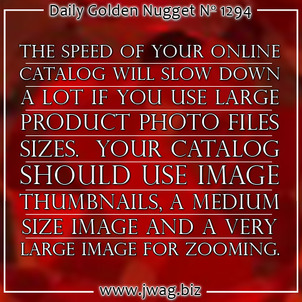
For this week's Throwback Thursday, I'm jumping to April 11, 2011 and my topic of speeding up your website images. This is an important topic that never gets old.
The internet has sped up tremendously since the days of dial up 14400 baud modems. Back then, it would take 45 seconds to download a 62K image; today, it takes only 1 second to download through cable and 4G connection speeds.
Although high speed internet is normal for most users now, you should still be sensitive to the size of your images and your user's connections--most particularly, their mobile connections.
On May 5, 2015, Google reported that mobile search broke through the 50% level. As of this writing, I see my own tracking for retail jewelers is only at 46.39%.
Regardless what numbers you follow, the fact is that your website is viewed through smartphones every day. The size of your images both affects your website speed and it uses your customer's precious cellular data plan.
As the throwback Nugget explains, you should use different size image files depending on where you need your product images to appear throughout your website. The thumbnail images are always the smallest and the zoom images on the product detail page are always the largest.
Some websites make the mistake of using the very large zoom image throughout their site and simply allow the web browser to resize them as needed. Although this might not be a problem anymore for high speed desktop computers, this practice will quickly eat through your customer data plans.
Mobile users with strong 4G and LTE mobile connections won't usually notice the extra second or so to download your large images, but they will notice when their signals are weak or they are stuck on 3G or even the E cellular network.
Correctly cropping and resizing your product catalog thumbnail images will greatly improve the experience of your mobile users. The faster speed of your mobile website will allow them to browse more quickly for their desired product, which, once found, they will be more than willing to wait the extra few seconds to download and view the highest resolution photographs.
All the product photos on your website should have 3 different sizes: a thumbnail, a medium size, and a large size to zoom in on. Determine the best pixel dimensions for each image according to the design of your website and the best experience for your users.








